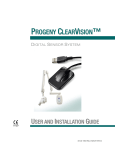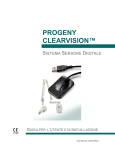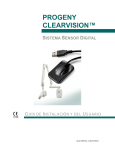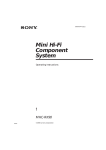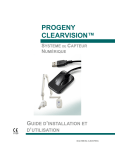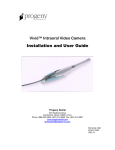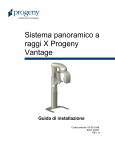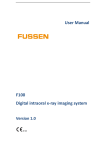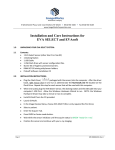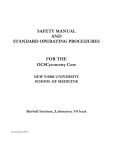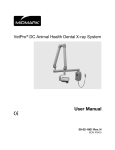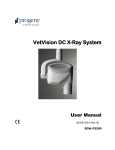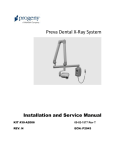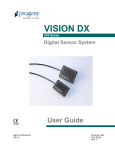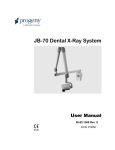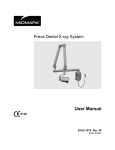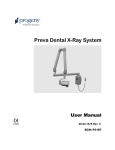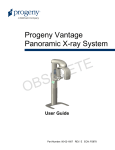Download User and Installation Guide
Transcript
VETPRO VDX ® D IGITAL S ENSOR S YSTEM USER AND INSTALLATION GUIDE 00-02-1673 Rev. C (ECN P2883) VETPRO® VDX DIGITAL SENSOR SYSTEM USER AND INSTALLATION GUIDE 00-02-1673 REV. C MIDMARK CORPORATION 675 HEATHROW DRIVE LINCOLNSHIRE, IL 60069, U.S.A. PHONE +1 (847) 415-9800 TOLL FREE (888) 924-3800 (U.S. ONLY) FAX: +1 (847) 415-9810 WWW.PROGENYDENTAL.COM Copyright © 2011 Midmark. All rights reserved. VetPro® VDX: User and Installation Guide TABLE OF CONTENTS General Information.................................................................................................................... 4 Indications for Use ............................................................................................................... 4 Contraindications ................................................................................................................. 4 Warnings/Precautions .......................................................................................................... 4 Product Description.............................................................................................................. 5 Explanation of Symbols on Technical Labels ........................................................................ 6 Compliance with Applicable Standards ................................................................................ 7 Obtaining Technical Support ................................................................................................ 9 Authorized Representatives .................................................................................................. 9 Installation ................................................................................................................................ 10 Overview ............................................................................................................................ 10 Before You Begin ................................................................................................................ 10 Installation Procedure ......................................................................................................... 11 Operating the VetPro® VDX Sensor .......................................................................................... 18 Acquiring Images................................................................................................................ 18 Using the Sensor Sheaths .................................................................................................. 19 Using a Sensor Positioning Device ........................................ Error! Bookmark not defined. Recommended Maintenance.............................................................................................. 19 Cleaning and Disinfecting ................................................................................................... 19 Specifications........................................................................................................................... 21 X-Ray Sensor ..................................................................................................................... 21 Environmental ..................................................................................................................... 21 Terms ....................................................................................................................................... 22 Warranty ................................................................................................................................... 22 00-02-1673 © 2011 Midmark • 675 Heathrow Drive, Lincolnshire, IL 60069, U.S.A. • Phone +1 (847) 415-9800 3 VetPro® VDX: User and Installation Guide General Information Indications for Use VetPro® VDX is intended to be used by veterinarians and other qualified professionals for producing diagnostic x-ray radiographs of dentition, jaws and other oral structures. Contraindications None known. Warnings/Precautions Radiation Safety • Only qualified and authorized personnel may operate this equipment observing all laws and regulations concerning radiation protection. • The operator at all times must remain at a safe distance from the focal spot and the X-ray beam for operator protection. • Full use must be made of all radiation safety features on the X-ray equipment. • Full use must be made of all radiation protection devices, accessories and procedures available to protect the patient and operator from X-ray radiation. Electrical Safety • The VetPro® VDX sensor cable should be handled with care. Do not sharply bend or crimp the sensor cable. Doing so could permanently damage the sensor. • This equipment must only be used in rooms or areas that comply with all applicable laws and recommendations concerning electrical safety in rooms used for medical purposes, e.g., IEC, US National Electrical code, or VDE standards. • Before cleaning or disinfecting, this equipment must always be disconnected from the electrical supply. • The computer and any other associated equipment (like USB hub) shall be placed outside the patient’s environment (i.e.: more than 1.5 meters away from the table). The operator shall not access the patient and such devices at the same time. • The computer and any other associated equipment shall be compliant with IEC 60950 or IEC 60601. Patient Safety • Prior to use always cover the sensor with a disposable hygienic protective cover. A new cover must be used for each patient. It is recommended to disinfect the sensor between uses. • The VetPro® VDX, Computer, and provided cables comprise a Medical Electrical System. The Computer is not intended to be located in the patient environment (within a 1.5 m radius of the patient). • System installation shall be in accordance with the requirements of IEC 60601-1, the Standard for Safety Requirements of Medical Electrical Systems 00-02-1673 © 2011 Midmark • 675 Heathrow Drive, Lincolnshire, IL 60069, U.S.A. • Phone +1 (847) 415-9800 4 VetPro® VDX: User and Installation Guide Product Description VetPro® VDX is a digital imaging system for dental radiographic application. The product is to be used for routine dental radiographic examinations such as bitewings, periapicals, etc. Two different sized sensors (size 1 and size 2) are utilized to image different anatomy and for different patient sizes. The CMOS sensor connects directly to a USB connection in a PC without the need for an intermediate electrical interface. VetPro® VDX works with a standard dental intraoral x-ray source without any connection to the x-ray source. VetPro® VDX captures an image automatically upon sensing the production of x-ray and after the x-ray is complete, transfers the image to an imaging software program on the PC. Disposable sheaths are used with each use to prevent cross-contamination between patients. VetPro® VDX Sensor is a state of the art intraoral x-ray detector intended for digital imaging of teeth and the oral cavity. The system provides: • Immediate production of an image • Digital image storage and management • Efficient archiving and recall of images • Elimination of film processing The components of the VetPro® VDX sensor system are the Digital Sensor internal USB Cables and, the Sensor Calibration Files. Digital Sensor The digital sensor is designed to transform a two dimensional X-ray picture into an electrical signal. The structure of the sensor is assembled with a first layer of phosphor material (scintillator) which, when exposed by incident Xrays, emits a luminous radiation. This light is then transferred to the photo sensitive elements of the Sensor where it is transformed to electrical potential. The electrical signal is sent to the computer for processing. Sensor Calibration Files During installation of the VetPro® VDX sensor system, files specific to the sensor serial number are stored on each computer where the sensor will be used. For more details, refer to the VetPro® VDX Installation section of this manual. Progeny Imaging Provides the user interface to acquire, store, retrieve, transmit, review and post process images acquired by the VetPro® VDX sensor system. For more details refer to the VetPro® VDX Installation section of this manual or the Progeny Imaging User Manual. NOTE The VetPro® VDX digital sensor is sensitive to intense UV light. Therefore, the sensor should be stored in the box provided and never exposed to direct sunlight for extensive periods of time. 00-02-1673 © 2011 Midmark • 675 Heathrow Drive, Lincolnshire, IL 60069, U.S.A. • Phone +1 (847) 415-9800 5 VetPro® VDX: User and Installation Guide Explanation of Symbols on Technical Labels Caution, consult accompanying documents Refer to operating instructions Class II equipment – provides double Isolation to protect against electric shock Type BF – provides additional protection against electric shock Degree of protection – IP67 means that sensor casting is : totally protected against dust, protected against the effect of immersion between 15 cm and 1 m. Direct current Serial number Catalogue number Date of manufacture Place of manufacture (manufacturer) 00-02-1673 © 2011 Midmark • 675 Heathrow Drive, Lincolnshire, IL 60069, U.S.A. • Phone +1 (847) 415-9800 6 VetPro® VDX: User and Installation Guide Compliance with Applicable Standards The following regulatory documents apply: General Safety IEC 60601-1:1995 Protection against electrical shock – Class II Degree of protection against electrical shock – Type BF Applied Part Degree of protection against ingress of water – IP67 Not suitable for use in the presence of flammable anesthetic mixture with air or with oxygen or nitrous oxide. EMI/EMC IEC 60601-1-2:2007 Degree of Protection IEC 60529: 2001 Imaging Performance IEC 61223-3-4:200 Degree of protection against ingress of water – IP67 Line pair resolution – better than 8 lp/mm Low contrast resolution – all holes visible EMC Statement Information regarding potential EMC interference and advice for avoidance • The VetPro® VDX sensor is considered as non-life-supporting equipment. While using VetPro® VDX sensors adjacent to other equipment, configuration should be carefully adjusted to ensure that electromagnetic interference (EMI) does not degrade performance. Specifically, mobile RF communications equipment can effect medical electrical equipment. Please refer to the EMC table below. • Usage limitation: VetPro® VDX sensors shall be used with IEC 60950 or IEC 60601 compliant computer. Also, any device between VetPro® VDX sensors and the computer (USB Hub) shall be compliant with IEC 60950 or IEC 60601. If not, this may result in degraded electromagnetic compatibility. Guidance and manufacturer's declaration - electromagnetic emissions The VetPro® VDX is intended for use in the electromagnetic environment specified below. The customer or the user of the VetPro® VDX should assure that it is used in such an environment. Emission test RF emission CISPR 11 RF emission CISPR 11 Harmonic emission IEC 61000-3-2 Voltage fluctuations/ flicker emissions IEC 61000-3-3 Compliance Electromagnetic environment – guidance Class B The VetPro® VDX uses RF energy only for its internal function. Therefore, its RF emissions are very low and are not likely to cause any interference in nearby electronic equipment. The VetPro® VDX is suitable for use in all establishments, including domestic establishments and those directly connected to the public low-voltage power supply network that supplies buildings used for domestic purposes. Group 1 Not Applicable Not Applicable 00-02-1673 © 2011 Midmark • 675 Heathrow Drive, Lincolnshire, IL 60069, U.S.A. • Phone +1 (847) 415-9800 7 VetPro® VDX: User and Installation Guide Guidance and manufacturer's declaration - electromagnetic immunity The VetPro® VDX is intended for use in the electromagnetic environment specified below. The customer or the user of the VetPro® VDX should assure that it is used in such an environment. Immunity test IEC 60601 test level Compliance level Electrostatic discharge (ESD) IEC 61000-4-2 ± 6 kV contact ± 8 kV air ± 6 kV contact ± 8 kV air Electrical fast transient/burst IEC 61000-4-4 ± 2 kV for power supply lines ± 1 kV for input/output lines ± 2 kV for power supply lines ± 1 kV for input/ output lines Not Applicable. Surge ± 1 kV line(s) to line(s) ± 2 kV line(s) to earth IEC 61000-4-5 Voltage dips, interruptions, < 5% UT (>95% dip in UT) for 0.5 cycle and voltage variations on < 40% UT (60% dip in UT) for 5 cycles < 70% UT (30% dip in UT) for 25 cycles power supply input lines < 5% UT (>95% dip in UT) for 5 s IEC 61000-4-11 Power frequency (50/60 Hz) 3 A/m magnetic field IEC 61000-4-8 NOTE: UT is the a.c. mains voltage prior to application of the test level. Electromagnetic environment – guidance Floors should be wood, concrete or ceramic tile. If the floors are covered with synthetic material, the relative humidity should be at least 30%. Mains power quality should be that of a transient/ burst supply lines typical commercial or hospital environment. Not Applicable. 3 A/m Power frequency magnetic fields should be at levels characteristic of a typical location in a typical commercial or hospital environment. Guidance and manufacturer's declaration - electromagnetic immunity The VetPro® VDX is intended for use in the electromagnetic environment specified below. The customer or the user of the VetPro® VDX should assure that it is used in such an environment. Immunity test Conducted RF IEC 61000-4-6 Radiated RF IEC 61000-4-3 IEC 60601 test level 3V 150 kHz to 80 MHz 3 V/m 80 MHz to 2.5 GHz Compliance level 3V 3 V/m Electromagnetic environment – guidance Portable and mobile RF communications equipment should be used no closer to any part of the VetPro® VDX equipment, including cables, than the recommended separation distance calculated from the equation applicable to the frequency of the transmitter. Recommended separation distance: 𝑑 = 1.2 × √𝑃 𝑑 = 1.2 × √𝑃 80 MHz to 800 MHz 𝑑 = 2.3 × √𝑃 800 MHz to 2.5 GHz Where P is the maximum output power rating of the transmitter in watts (W) according to the transmitter manufacture and d is the recommended separation distance in meters (m). Field strengths from fixed RF transmitters, as determined by an electromagnetic site survey, a should be less than the compliance level in each frequency range. b Interference may occur in the vicinity of equipment marked with the following symbol: NOTE 1: At 80 MHz and 800 MHz, the higher frequency range applies. NOTE 2: These guidelines may not apply in all situations. Electromagnetic propagation is affected by absorption and reflection from structures, objects, and people. a Field strengths from fixed transmitters, such as base stations for radio (cellular/cordless) telephones and land mobile radios, amateur radio, AM and FM radio broadcast and TV broadcast cannot be predicted theoretically with accuracy. To assess the electromagnetic environment due to fixed RF transmitters, an electromagnetic site survey should be considered. If the measured field strength in the location in which the VetPro® VDX is used exceeds the applicable RF compliance level above, the VetPro® VDX should be observed to verify normal operation. If abnormal performance is observed, additional measures may be necessary, such as re-orienting or relocating the VetPro® VDX. b Over the frequency range 150 kHz to 80 MHz, field strengths should be less than [V1] V/m. 00-02-1673 © 2011 Midmark • 675 Heathrow Drive, Lincolnshire, IL 60069, U.S.A. • Phone +1 (847) 415-9800 8 VetPro® VDX: User and Installation Guide Recommended separation distances between portable and mobile RF communications equipment and VetPro® VDX The VetPro® VDX is intended for use in the electromagnetic environment in which radiated RF disturbances are controlled. The customer or the user of the sensor can help prevent electromagnetic interference by maintaining a minimum distance between portable and mobile RF communications equipment (transmitters) and the sensor as recommended below, according to the maximum output power of the communications equipment. Rated maximum output power of transmitter, W Separation distance according to frequency of transmitter m 150 kHz to 80 MHz 80 MHz to 800 MHz 80 MHz to 2.5 GHz 𝑑 = 1.2 × √𝑃 𝑑 = 1.2 × √𝑃 𝑑 = 2.3 × √𝑃 0.12 0.12 0.23 0.37 0.37 0.74 1.17 1.17 2.34 3.69 3.69 7.38 11.67 11.67 23.34 For transmitters rated at a maximum output power not listed above, the recommended separation distance d in meters (m) can be determined using the equation applicable to the frequency of the transmitter, where P is the maximum output power rating of the transmitter in watts (W) according to the transmitter manufacturer. NOTE 1: At 80 MHz and 800 MHz, the separation distance for the higher frequency range applies. NOTE 2: These guidelines may not apply in all situations. Electromagnetic propagation is affected by absorption and reflection from structures, objects, and people. 0.01 0.1 1 10 100 Obtaining Technical Support Contact Midmark Corporation 675 Heathrow Drive Lincolnshire, IL 60069 Phone: +1 (847) 415-9800 Toll free (888) 924-3800 (U.S. Only) Fax: +1 (847) 415-9810 To facilitate your service call, the following information should be ready and available: • • • • Computer operating system Version of Progeny Imaging software Serial number of your sensor Type of Progeny Imaging installation (standalone, peer-to-peer network, client-server network) NOTE: It is recommended that the installing technician review the complete instructions before attempting to install or upgrade any component Authorized Representatives Europe CE Partner 4U Esdoornlaah 13 3951DB Maarn The Netherlands Phone: +31 (343) 442-524 Fax: +31 (343) 442-162 00-02-1673 © 2011 Midmark • 675 Heathrow Drive, Lincolnshire, IL 60069, U.S.A. • Phone +1 (847) 415-9800 9 VetPro® VDX: User and Installation Guide Installation Overview The VetPro® VDX Sensor System is an intraoral digital sensor used with an intraoral X-Ray generator to capture digital images of dentition and the surrounding skeletal structures The Sensor is available in two configurations: • Standalone – Sensor, connected directly to a PC • Integrated – Integrated into and part of the VetVision Complete or Prevavet Complete system. NOTE: The integrated version of is available as a retrofit kit for certain existing Progeny products. Before You Begin Computer and Software You must have a dedicated Computer with a 32-bit or 64-bit Windows operating system and have at least one High-speed USB port available. The computer requirements are listed in Table 1. Image capture and management software must be installed on all computers that will host the VetPro® VDX. The performance of that software is affected by the amount of RAM and storage memory available to the system for acquisition, displaying, storing, and printing digital X-Ray images. The recommended requirements are listed as a guideline only. NOTE: Be aware that the patient volume, and the specific demands of your practice, may require adjusting these guidelines accordingly. The system requirements of other programs operating on the same computer or network may affect these guidelines as well. Table 1: Recommended System Requirements Component Requirement Computer Hardware PC - compatible Pentium 4 / 1.4 GHz or greater computer Memory System 2 GB RAM or higher recommended (minimum 1 GB) Operating System Microsoft Windows XP Professional with Service Pack 3; Microsoft Vista (Business or Ultimate editions); Microsoft Windows 7 (Professional or Ultimate editions) Disk Space 450 MB minimum NOTE: Additional disk space is needed depending on the size of the practice, the number of images, and other information you plan to store. Each image is approximately 4 MB. For example, approximately 300 GB are needed to store 75 000 images. Display Settings 1024 x 768 (16 - bit or higher) with 32 MB (or higher) of Video RAM NOTE: It is possible to increase these settings based on the actual video adapter installed. As a rule, the better your video adapter or capture card the better your images. 00-02-1673 © 2011 Midmark • 675 Heathrow Drive, Lincolnshire, IL 60069, U.S.A. • Phone +1 (847) 415-9800 10 VetPro® VDX: User and Installation Guide Midmark requires the use of Progeny Imaging or Progeny Imaging Twain software. It must be installed on every computer that will interface with the Sensor. If you are not intending to use Progeny Imaging, then compatible image capture and management software must be installed on all computers to be used. This software may support direct integration with VetPro® VDX sensor (direct integration) or may use TWAIN interface. For installation and use of Progeny Imaging software, refer to the Progeny Imaging Installation Manual, or contact Technical Support. For installation and use of third party software that supports direct integration, refer to that software installation and user manuals. Check System Contents Verify that all items listed on the Packing List are contained in your system order. If any item appears to be missing, contact Technical Support immediately. For guidance refer to Figure 1. Tools Required No tools are required to install VetPro® VDX Sensor System. 45-A2005 Sensor Holder (Standalone sensor systems only) 45-A0024 Documentation Kit on USB Flash Drive XSDP-01 or XSDP-02 or XSDQ-01 or XSDQ-02 VetPro® VDX sensor 500-434 or 500-435 Sample pack of protective sheets Figure 1: Contents of VetPro® VDX Sensor System Installation Procedure Installing together with Progeny Imaging Software When installing the VetPro® VDX sensor drivers and associated software, it is assumed that previous versions of the Progeny Device Suite and Progeny Imaging image management software are not present. NOTE: Proper operation requires any previous version of Progeny Device Suite and Progeny Imaging to be removed (uninstalled) prior to the installation process to begin. Execute the following steps: • Insert the USB Flash Drive into an available USB port on your computer and allow the computer to recognize the flash drive. 00-02-1673 © 2011 Midmark • 675 Heathrow Drive, Lincolnshire, IL 60069, U.S.A. • Phone +1 (847) 415-9800 11 VetPro® VDX: User and Installation Guide • The main screen of the installation software is shown on Figure 2. If the software on the USB flash drive does not start automatically, navigate to Windows Explorer™ and select the “Progeny” drive letter. Browse to the content of the flash drive and start “Setup.exe”. This step begins the installation process. NOTE: The installation software requires Microsoft .NET Framework revision 3.5. This software will be installed if it is not yet present to the operating system. Follow all on screen prompts. NOTE: If the intended configuration is based on Windows XP, the Service Pack 3 update is required. This update is included on the USB flash drive and can be installed from folder named ‘Utilities’. Another option is to use the Windows update tool provided by Microsoft. Figure 2: Main screen of the Installation software • Start the installation process by clicking on ‘Install Progeny Device Suite’ button (Figure 3). NOTE: The installed software requires multiple software components that may already be available in your system. These components will be installed if they are not yet present. Follow all on screen prompts. Figure 3: Starting the Progeny Device Suite installation 00-02-1673 © 2011 Midmark • 675 Heathrow Drive, Lincolnshire, IL 60069, U.S.A. • Phone +1 (847) 415-9800 12 VetPro® VDX: User and Installation Guide • The screen on Figure 4 will be displayed. Choose “VetPro VDX” and all other device families that have to be supported by the Imaging Software. Figure 4: Selecting the device families to be installed • The dialog box shown on Figure 5 may appear when Progeny Device Suite is installed in Windows Vista and Windows 7 environments. Select ‘Always trust software from Midmark’ check box and click on the Install button. Figure 5: Enable Midmark software installation • A green check mark next to the ‘Install Progeny Device Suite’ button will appear when Progeny Device Suite installation is completed. Continue by installing Progeny Imaging software by clicking on ‘Install Progeny Imaging’ button (Figure 6) and follow the prompts on the screen to perform the installation. Figure 6: Starting the Progeny Imaging installation 00-02-1673 © 2011 Midmark • 675 Heathrow Drive, Lincolnshire, IL 60069, U.S.A. • Phone +1 (847) 415-9800 13 VetPro® VDX: User and Installation Guide • Green check marks next to each of the ‘Install Progeny Device Suite’ and ‘Install Progeny Device Suite’ buttons will appear when both the Progeny Device Suite and Progeny Imaging are installed (Figure 7). Figure 7: Progeny Device Suite and Progeny Imaging are installed Installing Sensor Calibration Files The VetPro® VDX sensor requires a calibration file to be installed for each device to operate correctly. This calibration file is unique for each sensor and it is provided on the USB flash drive. NOTE: The USB flash drive contains the unique sensor calibration file, the operation instructions and the sensor support software. Do not discard or reuse. Save and store the USB flash in a convenient location to allow future references to its content. The calibration files for the VetPro® VDX sensor are installed during the Progeny Device Suite installation from the provided USB flash drive. No additional installation is needed if only one sensor will be used in the installed configuration and the sensor support software was installed from the provided USB flash drive. Install the sensor calibration file by executing the following steps, if more than one sensor is needed, or if the current sensor is installed after the support software is installed, or if you are uncertain whether the sensor calibration file was installed. • Insert the USB flash drive that came with the VetPro® VDX sensor into an available USB port on your computer and allow the computer to recognize the flash drive. • The main screen of the calibration file installation is shown on Figure 8. If the software on the USB flash drive does not start automatically, navigate to Windows Explorer™ and select the drive letter labeled “Progeny”. Browse to the content of the flash drive and start “Setup.exe”. This step begins the installation process. NOTE: Do not run the Progeny Device Suite installation as that software is now installed. 00-02-1673 © 2011 Midmark • 675 Heathrow Drive, Lincolnshire, IL 60069, U.S.A. • Phone +1 (847) 415-9800 14 VetPro® VDX: User and Installation Guide Figure 8: Main screen of the calibration file installation • To add the calibration file onto your computer click on the “Add Calibration Files” button (Figure 9). Figure 9: Calibration file installation • The dialog box shown on Figure 10 will appear to allow selection of the calibration file(s) source folder. The initial selection will point to the source folder on the current USB flash drive. Navigate to the calibration file source folder if needed and click on the ‘OK’ button to continue. Figure 10: Select the source folder for the calibration file • A green check mark next to the ‘Add Calibration Files’ button will appear when the calibration files are installed (Figure 11). Exit from the installation 00-02-1673 © 2011 Midmark • 675 Heathrow Drive, Lincolnshire, IL 60069, U.S.A. • Phone +1 (847) 415-9800 15 VetPro® VDX: User and Installation Guide by clicking on the ‘Exit door’ icon as highlighted on Figure 11. Figure 11: Calibration files are installed Sensor Installation If a Standalone version is installed, plug the sensor into an available Highspeed USB port on the computer with installed sensor support software. Attach the Sensor Holder to a secure location near the computer and use it as a sensor storage location. If an Integrated version is installed, plug the sensor in the USB port available at the end of the Articulated Arm, near to the tube-head. Verify also that the USB hub embedded in the integrated system is connected with the provided cable to a High-speed USB port of the computer that contains the sensor support software. That connection has to be present for the Sensor to be operational. Attach the Sensor Holder to Articulated Arm near to the tube-head if it is provided separately. Use the Sensor Holder as a sensor storage location. A Windows device driver installation message will be displayed when the sensor is connected to an USB port for the first time. NOTE: A Windows device driver installation message will be displayed every time when the sensor is connected to a new USB port for the first time. No additional interaction is needed when the VetPro® VDX sensor is used in a Windows Vista and Windows 7 environment. If the VetPro® VDX sensor is used in a Windows XP environment, an installation device wizard may appear (Figure 12). Follow the steps bellow to complete the installation. • Select ‘Yes, this time only’ from the dialog box and press the ‘Next’ button (Figure 12). 00-02-1673 © 2011 Midmark • 675 Heathrow Drive, Lincolnshire, IL 60069, U.S.A. • Phone +1 (847) 415-9800 16 VetPro® VDX: User and Installation Guide Figure 12: Found New Hardware Wizard in Windows XP (first screen) • Select ‘Install the software automatically’ and continue by pressing the ‘Next’ button (Figure 13). Follow the wizard instructions and prompts to complete the drive installation. Figure 13: Found New Hardware Wizard in Windows XP (second screen) Sensor Selection in Progeny Imaging The VetPro® VDX sensor could be used once Progeny Imaging software is started as it is described in Progeny Imaging Installation Manual. To select the VetPro® VDX sensor use the ‘Device Control Toolbar’ by following the steps bellow. • Select VetPro VDX as shown on Figure 14. Figure 14: Selecting VetPro® VDX sensor in Progeny Imaging • Once VetPro VDX is selected you will see a green LED (Figure 15). This verifies the sensor is now connected to the computer. Figure 15: Successful VetPro® VDX sensor selection 00-02-1673 © 2011 Midmark • 675 Heathrow Drive, Lincolnshire, IL 60069, U.S.A. • Phone +1 (847) 415-9800 17 VetPro® VDX: User and Installation Guide Operating the VetPro® VDX Sensor Acquiring Images Prerequisites • Install the imaging software following the installation steps provided with the product. • Connect the VetPro® VDX sensor as described in this guide. Connect the Sensor 1. Connect the VetPro® VDX X-Ray Sensor to the computer (standalone configuration) or to the USB Interface connector on the Progeny Articulated Arm (in the case of the integrated system configuration). NOTE: Always attach the sensor and the integrated system to an USB port that complies with the USB specification and supports High-speed transfer. Use only USB certified components that support Highspeed transfer if an additional USB hub or USB cable is needed. Attaching the sensor to a different port or using different components and cables will degrade sensor performance. (Contact Progeny technical support or refer to the Service and Installation manual for further information). Taking images 1. Refer to the specific imaging software manual for X-ray image acquisition. NOTE: We recommend the use of Progeny Imaging image management software. Incompatible software will not allow sensor operation. 2. Verify that the X-ray system exposure parameters are adequate for the desired examination. 3. Insert the X-ray sensor into a sensor sheath and then position the sensor inside the patient’s mouth in the desired position. 4. Position the tube head of the X-ray system to the patient, using standard positioning procedures. 5. Activate the VetPro® VDX via the imaging software (refer to the software guide). 6. Repeat steps 1-5 for additional images. 00-02-1673 © 2011 Midmark • 675 Heathrow Drive, Lincolnshire, IL 60069, U.S.A. • Phone +1 (847) 415-9800 18 VetPro® VDX: User and Installation Guide Using the Sensor Sheaths A sample pack of sanitary sheaths is included with your sensor. Sheaths are necessary to avoid patient cross contamination. Care must be exercised when placing sheaths on sensors or in positioning device. If you suspect the sheath integrity has been compromised, discard and do not use. The sheaths are not sterile and are intended as a single use item. Dispose of used sheaths appropriately. To order more sheaths, contact Progeny or your Progeny dealer. 1. Follow the procedure below prior to every use of the sensor. Hold sheath and insert sensor into opening between the white tab and the paper. 2. Gently slide the sensor into the sheath until it reaches the tip of the sheath. Do not force it. 3. Peel back the protective cover. 4. Peel away the paper backing. The sensor is now protected and ready for normal use. Figure 16: Using protective sensor sheath 5. After use, slide the sensor out of the sheath delicately using the thumb. DO NOT pull the cable while removing the protective sheath. Recommended Maintenance VetPro® VDX sensors do not require maintenance. Disinfection is recommended between every use. Cleaning and Disinfecting NOTE: Disinfection of the VetPro® VDX sensor is the sole responsibility of the user according to their practice protocol and the instructions, requirements, and limitations of the disinfecting agent being used, as per the manufacturer of the agent. The VetPro® VDX sensor should be cleaned according to the following procedure: 1. The VetPro® VDX sensor and associated cables may be disinfected by wiping with a high level EPA registered hospital disinfectant as per manufacturer's directions. 2. Use personal protection equipment during the disinfecting process. 3. Disinfect the sensor and the first 10 centimeters of the sensor cable only, 00-02-1673 © 2011 Midmark • 675 Heathrow Drive, Lincolnshire, IL 60069, U.S.A. • Phone +1 (847) 415-9800 19 VetPro® VDX: User and Installation Guide before first use, and before any new patient. 4. Use a new sanitary sheath for each patient. The sheath must be biocompatible following the standard ISO 10993-1. Sheaths provided by Progeny meet this standard. 5. Wipe the sensor surface (not the cable) with a gauze sponge moistened with a disinfecting solution. 6. Disinfection by immersion with a disinfecting solution is preferred. Follow the disinfectant manufacturers recommended immersion time, and other instructions. 7. The sensor cable can be soaked in a disinfecting solution as long as there is no mechanical damage to the sensor or the cable. If mechanical damage is recognized, consult with Progeny technical support before attempting to immerse the sensor or cable. 8. Dry the sensor before placement in the next sanitary barrier. 9. Important: • Do not immerse the USB connector in a disinfecting solution. • Do not clean the sensor or cable with abrasive tools. • Do not use disinfectants that contain bleach or alcohol. Do not heat sterilize or autoclave the sensor as this will damage the electronics and enclosure, thus voiding the warranty. Preferred disinfecting liquids: • CIDEX OPA (trademark of Johnson and Johnson) • DENTASEPT (trademark of Anios Laboratories) • RELYON (trademark of Phagogene Dec. Laborotories) Never use: • • • • • Alcohols (Isopropyl Alcohol, Methanol) SEKUSID-N (trademark of Ecolab Paragerm Laboratories SEKUSEPT Easy (trademark of Ecolab Paragerm Laboratories FD333 (trademark of Durr Dental Laboratories) FD322 (trademark of Durr Dental Laboratories) 00-02-1673 © 2011 Midmark • 675 Heathrow Drive, Lincolnshire, IL 60069, U.S.A. • Phone +1 (847) 415-9800 20 VetPro® VDX: User and Installation Guide Specifications X-Ray Sensor Film Size equivalent Size 1 (37 mm x 24 mm) Active Area (Size 1) 600 mm2 Size 2 (43 mm x 30 mm) (Size 2) 900 mm2 Number of Pixels 1.65 million Pixels (Size 1) Pixel Size 19 µm x 19 µm Theoretical Resolution 27 lp/mm Dynamic Range 72 dB Sensor Cable 3 m or 0.9 m Connection type High Speed USB Power Supply +5 V, per USB 2.0 specification Level of Protection IP67 (sensor only, per IEC 60529) 2.59 million Pixels (Size 2) Environmental Operating Temperature between +5 ºC and +35 ºC (between +41 ºF and +95 ºF) Storage Temperature between -40 ºC and +70 ºC (between -40 ºF and +158 ºF) Operating humidity 5% to 85 % operating humidity Storage humidity 10% to 90% non-condensing, storage humidity 00-02-1673 © 2011 Midmark • 675 Heathrow Drive, Lincolnshire, IL 60069, U.S.A. • Phone +1 (847) 415-9800 21 VetPro® VDX: User and Installation Guide Terms Film Size Equivalent The size of the X-ray sensor active area in relation to traditional film based Xray systems available to the veterinary profession. Active Area The equivalent sensor area used to produce an image, measured in square millimeters (mm2). The larger the number, the larger the active area. Number of Pixels The total number of pixels in the sensor active area. It has no unit value; however, a larger number results in a finer image. Pixel Size The size of the smallest discrete picture element used in the process of image acquisition, measured in micrometers (µm). The smaller the pixel size, the finer the image. Theoretical Resolution Measures the maximum level of detail that the sensor system is capable of acquiring, measured in line-pairs per millimeter (lp/mm). The larger the number, the finer the image. Dynamic Range Represents the largest output of the device as a ratio to the smallest output, measured in decibels (dB). A larger number shows a greater X-ray exposure range in which the X-ray sensor system can produce an image without degradation. Sensor Cable Identifies the type and length of the sensor cable. Connection Type Specifies the connection type used to attach the sensor system to the computer. Warranty A separate Warranty Registration form has been included with your system. Please complete and return it immediately to validate your warranty and receive technical support. Progeny cannot offer technical support or assistance unless your product has been registered. Extended Warranty Options are available. For more details, contact Progeny or your dealer. 00-02-1673 © 2011 Midmark • 675 Heathrow Drive, Lincolnshire, IL 60069, U.S.A. • Phone +1 (847) 415-9800 22






















